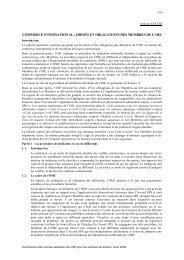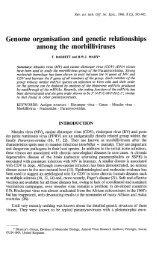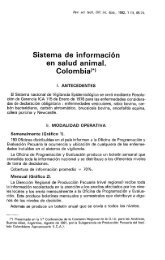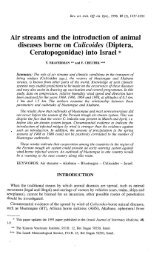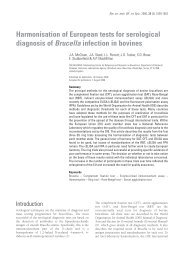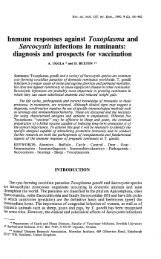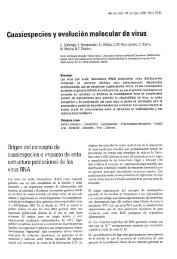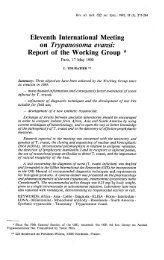Clinical variation in foot and mouth disease: sheep and goats
Clinical variation in foot and mouth disease: sheep and goats
Clinical variation in foot and mouth disease: sheep and goats
Create successful ePaper yourself
Turn your PDF publications into a flip-book with our unique Google optimized e-Paper software.
510 Rev. sci. tech. Off. <strong>in</strong>t. Epiz., 21 (3)<br />
test to be used. Adaptations of the PCR could also provide a<br />
more rapid diagnosis, either to detect viral genome <strong>in</strong> nasal<br />
swabs before the development of cl<strong>in</strong>ical <strong>disease</strong>, or for use <strong>in</strong><br />
portable mach<strong>in</strong>es taken to suspect premises (8).<br />
Once the sample is received by a competent diagnostic<br />
laboratory, <strong>and</strong> assum<strong>in</strong>g the sample was properly collected<br />
<strong>and</strong> stored dur<strong>in</strong>g transport, the available tests are extremely<br />
sensitive <strong>and</strong> specific, <strong>and</strong> for positive samples, the result can<br />
usually be available <strong>in</strong> a few hours. However, before the<br />
laboratory can report that no virus was detected, the sample<br />
must be passaged on tissue culture <strong>and</strong> then bl<strong>in</strong>d-passaged a<br />
further one or two times, each passage requir<strong>in</strong>g 48 hours.<br />
Thus a week may elapse after receipt of a sample <strong>and</strong> before a<br />
f<strong>in</strong>al report is issued from the laboratory. This can <strong>and</strong><br />
frequently does cause some frustration with the field staff, as<br />
quarant<strong>in</strong>e <strong>and</strong> movement restrictions would probably have<br />
been kept <strong>in</strong> place until a result was available. However, there<br />
are many examples where prelim<strong>in</strong>ary negative results have<br />
been issued <strong>and</strong> restrictions prematurely removed, <strong>and</strong> then the<br />
f<strong>in</strong>al result has been reported positive.<br />
Control<br />
The control of FMD <strong>in</strong> <strong>sheep</strong> <strong>and</strong> <strong>goats</strong> follows the same<br />
pr<strong>in</strong>ciples as would apply to the <strong>disease</strong> <strong>in</strong> other susceptible<br />
farm livestock, i.e. movement restrictions, dis<strong>in</strong>fection <strong>and</strong><br />
either slaughter of affected <strong>and</strong> <strong>in</strong>-contact animals or<br />
vacc<strong>in</strong>ation. In countries previously free from FMD, an <strong>in</strong>itial<br />
attempt is usually made to eradicate the <strong>disease</strong> by slaughter.<br />
However, most countries will reta<strong>in</strong> the option to vacc<strong>in</strong>ate <strong>and</strong><br />
thus ma<strong>in</strong>ta<strong>in</strong> membership of a vacc<strong>in</strong>e bank which can<br />
provide vacc<strong>in</strong>e at short notice. In countries that have endemic<br />
FMD, <strong>sheep</strong> may be <strong>in</strong>cluded <strong>in</strong> regular vacc<strong>in</strong>ation campaigns,<br />
although they are rarely vacc<strong>in</strong>ated more than once a year.<br />
Sheep <strong>and</strong> <strong>goats</strong> are usually given half or a third of the cattle<br />
vacc<strong>in</strong>e dose, <strong>and</strong> either oil or alum<strong>in</strong>ium hydroxide/sapon<strong>in</strong><br />
adjuvants can be used. The duration of immunity aga<strong>in</strong>st<br />
<strong>disease</strong> will depend on the severity of challenge with live virus<br />
<strong>in</strong> the field, the antigenic relationship between the vacc<strong>in</strong>e<br />
stra<strong>in</strong> <strong>and</strong> the field virus <strong>and</strong> the potency of the vacc<strong>in</strong>e used.<br />
The often silent nature of the <strong>disease</strong> <strong>in</strong> adult <strong>sheep</strong> <strong>and</strong> <strong>goats</strong><br />
can also give the impression that the vacc<strong>in</strong>ation programme<br />
has been successful, when <strong>in</strong> reality the virus is circulat<strong>in</strong>g<br />
freely. The ability of the particular stra<strong>in</strong> to ma<strong>in</strong>ta<strong>in</strong> itself <strong>in</strong> the<br />
small rum<strong>in</strong>ant population becomes critical <strong>in</strong> these situations,<br />
but, as discussed above, has so far received little attention.<br />
Attempts to vacc<strong>in</strong>ate the national <strong>sheep</strong> population are usually<br />
h<strong>in</strong>dered by the numbers <strong>in</strong>volved, the cost of vacc<strong>in</strong>ation, <strong>and</strong><br />
the resources required to adm<strong>in</strong>ister the vacc<strong>in</strong>e. The <strong>in</strong>itial<br />
<strong>in</strong>tention to <strong>in</strong>clude <strong>sheep</strong> <strong>and</strong> <strong>goats</strong> <strong>in</strong> the vacc<strong>in</strong>ation<br />
campaign throughout Turkey was recognised as unrealistic.<br />
Vacc<strong>in</strong>ation was therefore targeted at all susceptible stock <strong>in</strong><br />
European Turkey (Thrace) <strong>and</strong> only certa<strong>in</strong> areas of Anatolia.<br />
Similarly, Morocco concentrated on vacc<strong>in</strong>at<strong>in</strong>g <strong>sheep</strong> <strong>and</strong><br />
<strong>goats</strong> on the border with Algeria, together with strategic<br />
vacc<strong>in</strong>ation around affected areas dur<strong>in</strong>g the last outbreak of<br />
FMD <strong>in</strong> the country. Uruguay vacc<strong>in</strong>ated only the cattle<br />
population dur<strong>in</strong>g the f<strong>in</strong>al stages of the successful FMD<br />
eradication programme undertaken <strong>in</strong> the early 1990s, <strong>and</strong> left<br />
the approximately 20 million <strong>sheep</strong> unvacc<strong>in</strong>ated dur<strong>in</strong>g this<br />
period.<br />
Conclusion<br />
The recent UK experience has demonstrated the importance of<br />
<strong>sheep</strong> <strong>in</strong> the epidemiology of FMD caused by certa<strong>in</strong> stra<strong>in</strong>s of<br />
virus. The difficulties encountered <strong>in</strong> identify<strong>in</strong>g cl<strong>in</strong>ical <strong>disease</strong><br />
resulted <strong>in</strong> large numbers of healthy animals be<strong>in</strong>g slaughtered,<br />
while other <strong>in</strong>fected flocks went unrecognised, allow<strong>in</strong>g the<br />
virus to spread. While some would argue that the policy<br />
adopted was effective <strong>and</strong> the overkill justified (10), a more<br />
traditional approach of methodical trac<strong>in</strong>g <strong>and</strong> laboratory<br />
test<strong>in</strong>g may have been equally effective, less expensive <strong>and</strong><br />
morally more defensible. Both sides of the argument would<br />
however probably agree on the need for more rapid <strong>and</strong> reliable<br />
on-farm diagnosis, <strong>and</strong> a better underst<strong>and</strong><strong>in</strong>g of the natural<br />
history of FMD <strong>in</strong> small rum<strong>in</strong>ants.<br />
■<br />
© OIE - 2002





